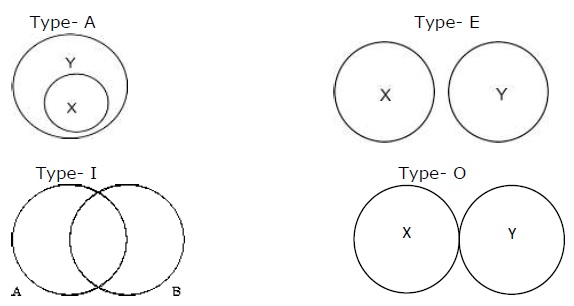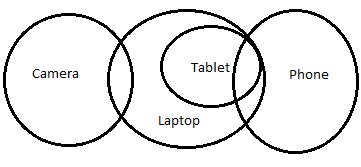
- Reasoning - Home
- Reasoning - Overview
- Reasoning
Reasoning - Syllogism
The meaning of syllogism as given by Greeks is Deduction. Its a kind of logical argumentation.
Definition of some important terms
There are some terms given below which have important role in solving problems on syllogism.
-
Proposition − proposition is a sentence which makes statements. Proposition consists of 3 parts these are a) subject, b)predicate and c) the relation between subject and predicate. Some propositions are given below.
- All coasts are beaches.
- No students are honest.
- Some documents are secret.
Subject and Predicate − Subject is that part about which something is being said. On the other hand, predicate is the part which is related to subject. For example − from the above propositions coasts, students, documents are subjects while beaches, honest, and secret are predicates.
Types of Categorical Proposition
-
Universal Proposition − Universal proposition is that which either includes subject fully or exclude it entirely. For example- No students are brainy. Universal proposition is further classified into following −
Universal positive proposition − When the form is all X are Y then it is called positive proposition. It is generally denoted by letter A.
Universal negative proposition − When the form is no X are T, then it is called as negative proposition. It is denoted by E.
-
Particular proposition − It is the proposition that shows subject partially or exclude it partly but not completely. For instance, some cats are cotton. It is also divided into following types −
Particular positive proposition − Forms like some X are U are called particular positive proposition. They are coded as I.
Particular negative proposition − Forms like Some T are not P for Instance, some cats are not coils is called particular negative proposition and coded as O.
Mediate inference − Here conclusion is taken from two statements. Example − all lips are coils and all balls are bats. So the conclusion will be all lips are coils.
Immediate inference − Here conclusion will be taken from only one proposition. For instance, if the statement is all teachers are god then conclusion will be some teachers are god.
Two important methods of immediate inference
These methods include conversion, contraposition etc.
Implications − Suppose given that all cats are beaches, then it shows that the conclusion some cats are beaches is true. So if a given proposition is of A-category, then it also shows that I-type conclusion must be true.
-
Conversion − It consists of 2 steps.
Step 1 − The subject will be converted into predicate and vice versa.
Step 2 − The proposition which is given will be changed accordingly.
For Example −
Statements − All the cats are racks. All the bags are racks. Some purses are bags.
Conclusions −
1. Some cats are bags.
2. Some racks are cats.
3. Some racks are purses.
A - Only 1
B - Only 2 and 3
C - Only 1 and 2
D - Only 1 and 3
Solution −
Answer - Option B
Pictorial way of representing propositions are formulated by Euler. There are four ways in which the relation could be made according to four propositions.

Type − A stands for All X are Y, Type − E stands for No X are Y, Type − I stands for Some A are B and Type − O stands for Some X are not Y.
For Example −
Statements −Some cameras are laptops.
Some laptops are phones.
Some phones are tablets.
Conclusions −
I - At least some tablets are cameras
II - There is a possibility that all tablets are laptops
III - None of the tablets are laptop
Solution −
Circle Diagram −

As per the above diagram,
Conclusion III follows. But possibility word has been mentioned in the statement. So lets check for the possibilities.
New diagram will be −

But in this case, conclusion III does not follow. Either conclusion II or conclusion III follows.